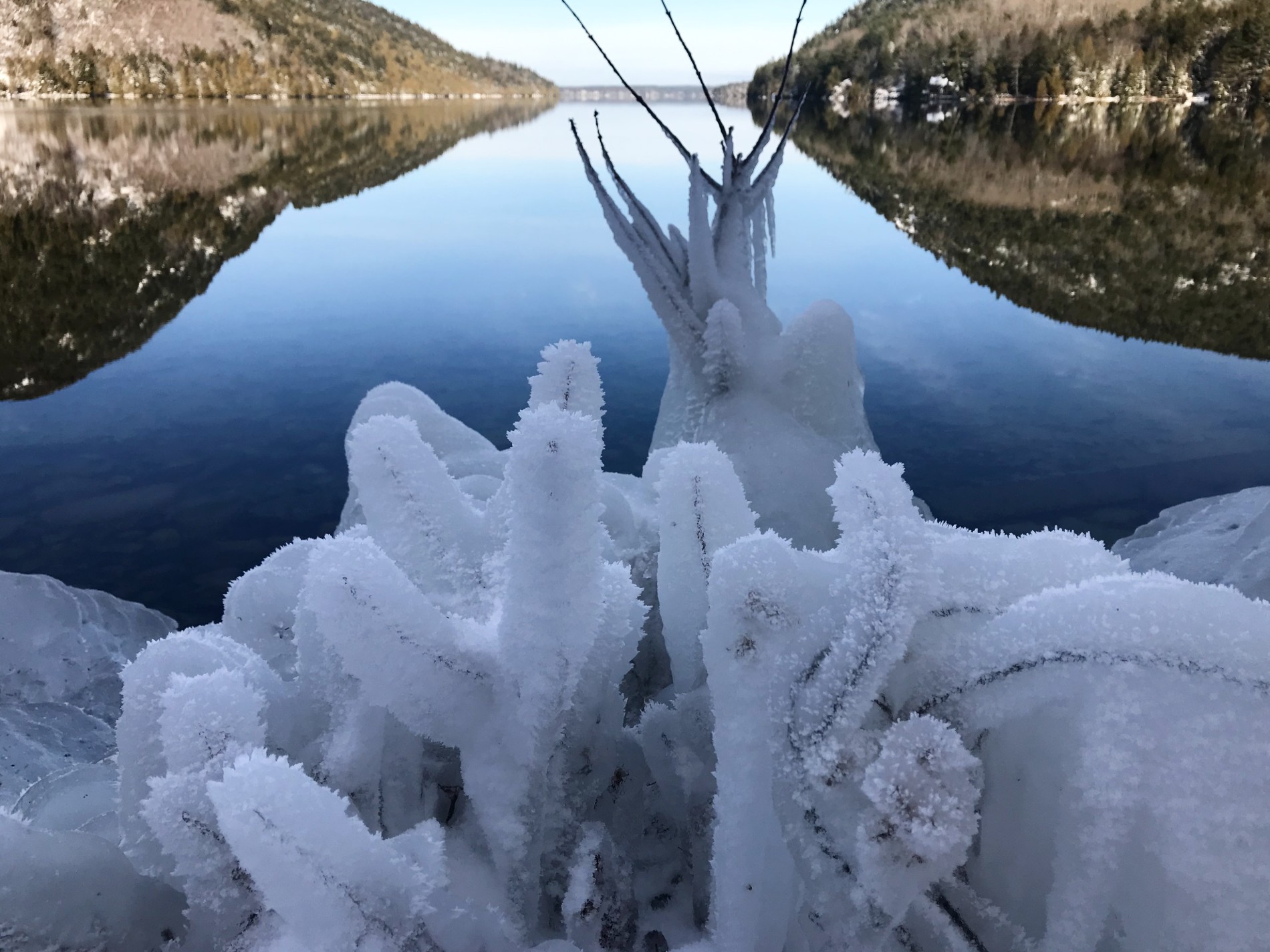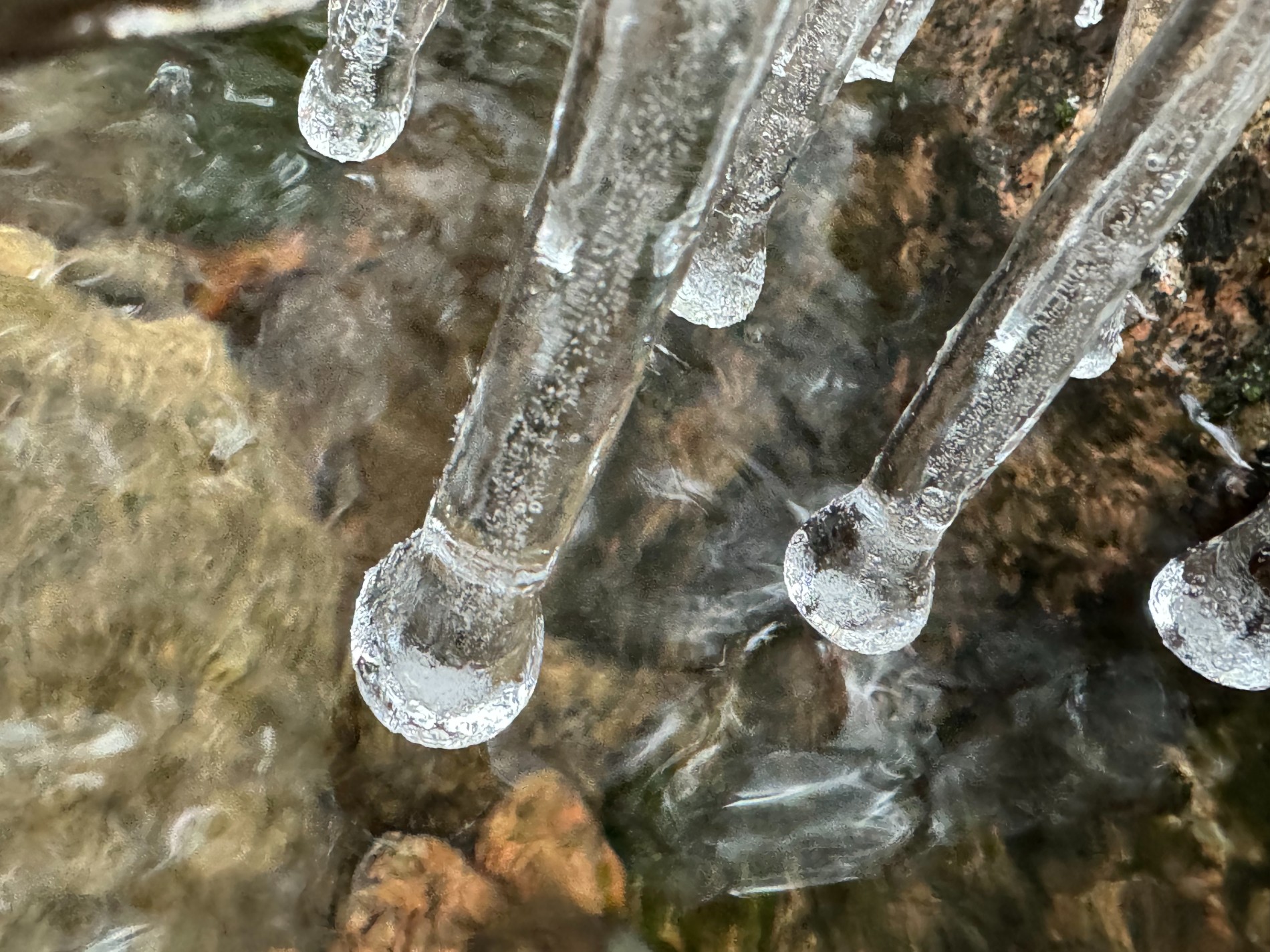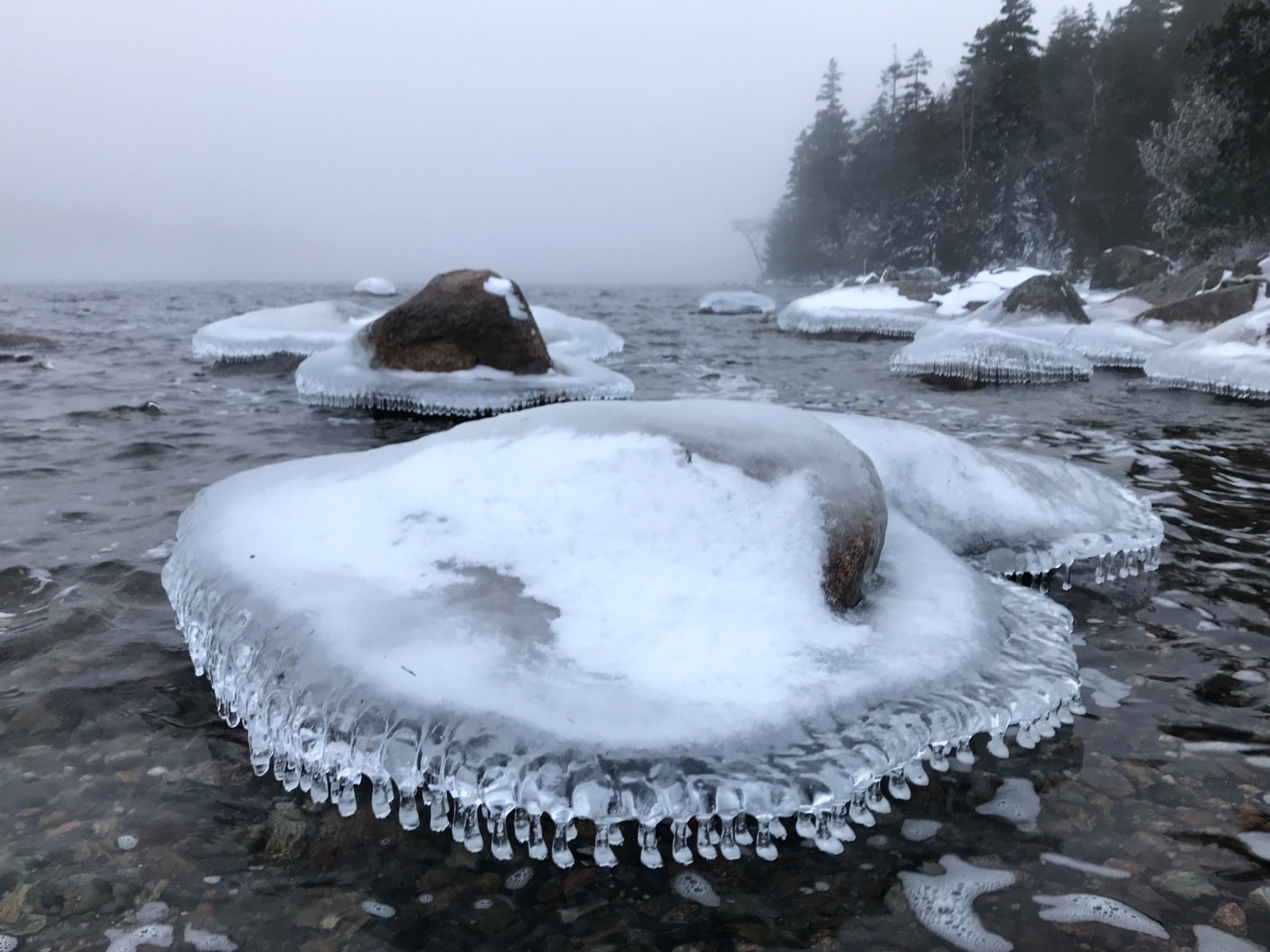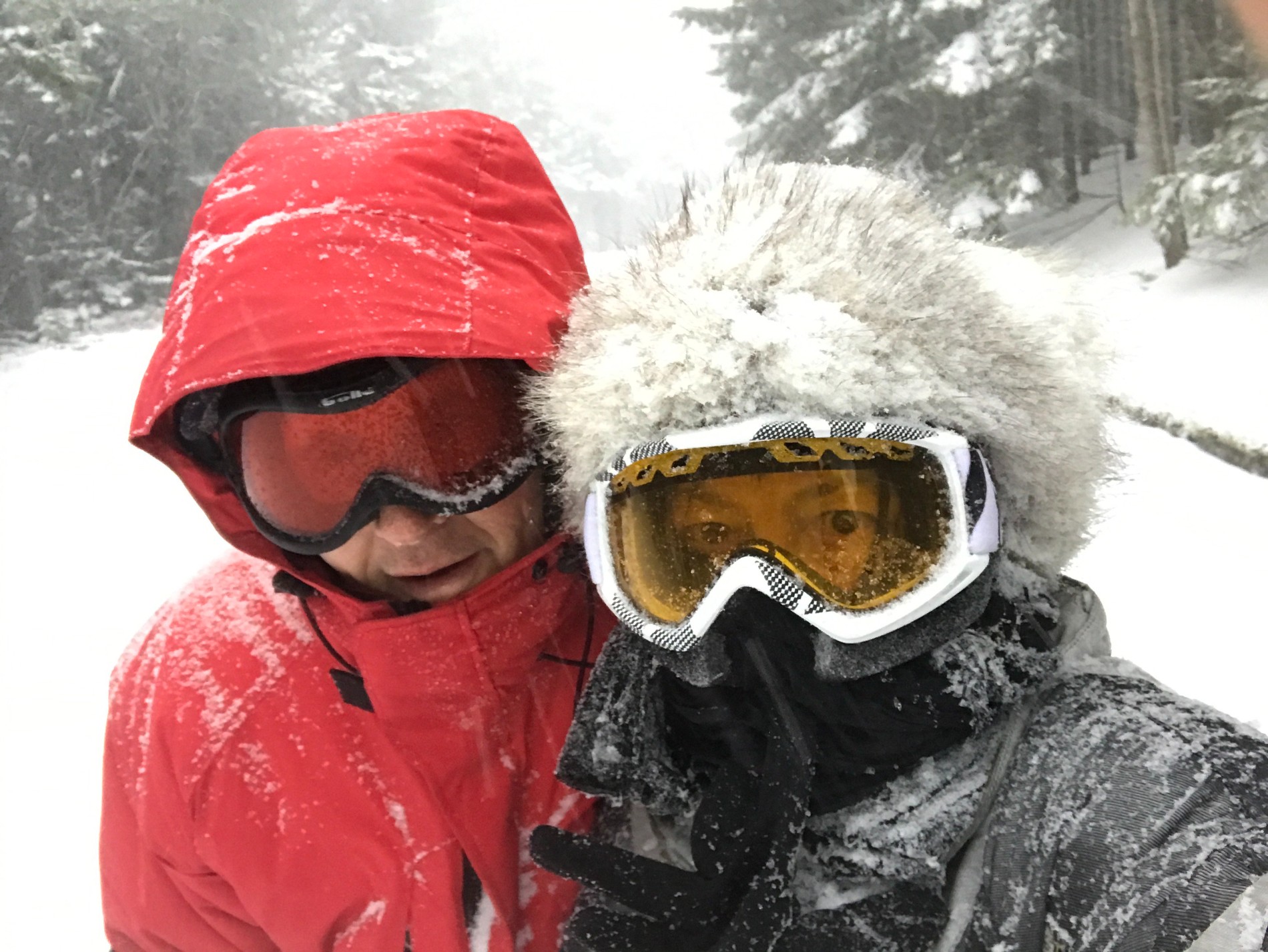The Snow-Covered Intimacy of Winter in Acadia
April 1st, 2025
April 1st, 2025
BY KAREN OLGA ZIMMERMANN
I love hiking Acadia in spring, when the trails are bursting with fresh chartreuse leaves. Dining outside at 10 p.m. because the sun has finally gone down is one of the joys of summer. Autumn, with the first scent of woodsmoke and colorful trees is vibrant and inviting. Spring, summer, and fall are fine, but winter, with its cold, snow, and ice, brings me alive.
Winter grounds me in a way the other seasons do not. The biting cold, the sparkling brilliance of a snow-covered field, the instant freezing of nostril hairs when I inhale—these all connect me to our climate and our world more intimately than any other season.
There is also a deep communal awareness of the grandeur and power winter offers. An acquaintance I passed on a snowy path one morning said to me, “Those Florida snowbirds just do not know what they are missing,” as we both looked at the sun shining through a mass of tinkling ice-coated twigs. The beauty was undeniable.

Winter frost gathers on vegetation. (Photo courtesy Karen Olga Zimmermann)
Winter brings challenges—some may complain about shoveling, the occasional frozen pipe disaster, or the winter storm that closes schools —but we help each other. While this happens year-round, in winter it includes a deeper feeling of unity and bonding. Businesses sometimes refer to those who stay rather than go as “the Winter People.” It fits. This is our place.
There is skiing, snowshoeing, and hiking up icy trails with microspikes. When the ice is good, simply walking across the flat, open expanse of a frozen lake is an adventure. When Jordan Pond freezes, it feels like a festival.
Long blade skaters skim by, and you may hear the eerie vibrations from their weight bending the ice. Parents walk the pond towing their children tucked deep into blankets on a sled. People are fishing. A look down an ice hole reveals another world, and you see how thick the ice is, with its silvery layers.
Jordan Pond is a mecca for ice seekers, where there is a palpable feeling of good spirits in the air. It is rare to pass another winter explorer without a friendly exchange.
Other ponds are smaller and offer a quieter adventure.

Winter frost gathers on vegetation. (Photo courtesy Karen Olga Zimmermann)

Drops of meltwater cling to the ends of icicles. (Photo courtesy Karen Olga Zimmermann)
One sunny, single-digit day, I walked Lake Wood, near the north end of Acadia. Boot prints, heart-shaped tracks of white-tailed deer, and the tiny pattern with the telltale tail-drag of a mouse showed I was not the first to use this road since it snowed. Chickadees and a red squirrel called as I approached the lake. Lake Wood groaned and snapped, booming as it expanded, “making ice” as some call it.
Most liquids contract as they freeze, but water, forming intricate crystals with space between the branches and spikes of each exquisite structure, expands. When it has nowhere to go, it cracks and booms. There was one loud explosive bellow, then, a gentle reply. The sound bounced off the surrounding ledges repeating itself more and more softly until silence returned.
Lake Wood is a small lake, and the booms were modest, not heart-stopping, as they can be on bigger waters. The surface of the lake, so perfectly flat and level, was puckered with the imprints of what seemed to be a thousand small cat paws, a chance pattern of the wind.
I knelt and traced the outline of one imprint. I imagined the party of prancing, leaping cats that might have left such patterns in the ice. As I stood, I looked across the lake and saw the focused, unwavering trail of a coyote—this was not an imaginary creature. I had passed human and dog track on the road in, and the erratic roam and sniff trail of the domestic dog is strikingly different from this animal in the wild, for whom conserving energy is a matter of survival.
Following the streamside path to Fawn Pond, I came to a pool just below a beaver dam. A skim of ice was exposed at its edge. Black ice. The name sounds fearsome, implacable, but the underwater scene it reveals is beautiful in its otherworldliness.

Ice builds around rocks. (Photo courtesy Karen Olga Zimmermann)
I laid on my belly and peered through the ice. I could see thin grasses waft slowly in the current. The sunlight pierced through to the bottom, illuminating a few gray and gold speckled rocks, but they were as far away as the moon. I could not touch them; they were on the other side of that invisible ice wall.
This barrier makes the world below even more compelling. I was on the outside looking in, and I wanted to dive down and explore.
Under the surface, a small twig shifted and dipped. A caddisfly larva had changed its center of balance and clung, bouncing gently, to the branch. It wore a case it had made of bits of rock and twig and weed, and, until it moved, seemed part of debris on the pool’s bottom.
Confined behind clear ice, this larva—creeping, barely moving as it went about its business—seemed to have no relation to the swarms of long-antennaed shadflies, or caddisflies, that will be in my face and hair a few months from now.
The rhythmic tapping of a pileated woodpecker resounded in the distance, and I pulled myself away from that hidden world to head home.
It was a short adventure, perhaps only two and a half miles total. There were remote worlds and minute details. There were signs from deer, dogs, humans, coyotes, mice, woodpecker, red squirrels, chickadees, caddisfly larva, and beaver. I was content.

Karen Olga Zimmermann and her late husband,
Dennis Smith, revel in a snowstorm.
For decades, I shared this winter joy with my late husband, a fellow snow lover. If we were not together at first snow, Dennis would call me at work, or I would try him on his phone. We always shared the excitement of those first flurries, however modest they were, and often celebrated with a bonfire.
We would watch the snow drift down and stretch our hands out to catch the occasional flake. We wondered if we knew who it was, as each snowflake has a bit of organic matter or dust at its core and could be anything, or anyone.
Knowing that reminds me how connected everything is and gives me comfort when I miss him.
I walked the road from Lake Wood back to my car, kicking light powder into the air simply to watch it sparkle. It landed softly and may not have melted that day, but there is no doubt it will melt. Whatever bit was at the center of each flake will rest on the earth. The earth will warm, the days will lengthen, and emerging buds will don their spring green colors. Spring, summer, and fall lie ahead to be enjoyed, but winter will follow, and, once again, we will be the winter people.
KAREN OLGA ZIMMERMANN is a Maine Master Naturalist, Registered Maine Guide, and a lover of winter. She lives in Otter Creek where she writes about all the seasons and gets out in them at every opportunity.